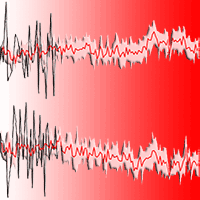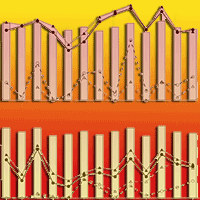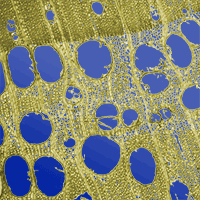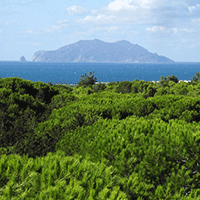Tree growth depends, among other factors, largely on the prevailing climatic conditions. Therefore, changes to tree growth patterns are to be expected under climate change. Here, we analyze the tree-ring growth response of three major European tree species to projected future climate across a climatic (mostly precipitation) gradient in northeastern Germany. We used monthly data for temperature, precipitation, and the standardized precipitation evapotranspiration index (SPEI) over multiple time scales (1, 3, 6, 12, and 24 months) to construct models of tree-ring growth for Scots pine (Pinus sylvestris L.) at three pure stands, and for common beech (Fagus sylvatica L.) and pedunculate oak (Quercus robur L.) at three mature mixed stands. The regression models were derived using a two-step approach based on partial least squares regression (PLSR) to extract potentially well explaining variables followed by ordinary least squares regression (OLSR) to consolidate the models to the least number of variables while retaining high explanatory power. The stability of the models was tested through a comprehensive calibration-verification scheme. All models were successfully verified with R²s ranging from 0.21 for the western pine stand to 0.62 for the beech stand in the east. For growth prediction, climate data forecasted until 2100 by the regional climate model WETTREG2010 based on the A1B Intergovernmental Panel on Climate Change (IPCC) emission scenario was used. For beech and oak, growth rates will likely decrease until the end of the 21st century. For pine, modeled growth trends vary and range from a slight growth increase to a weak decrease in growth rates. The climatic gradient across the study area will possibly affect the future growth of oak with larger growth reductions towards the drier east. For beech, site-specific adaptations seem to override the influence of the climatic gradient. We conclude that Scots pine has great potential to remain resilient to projected climate change without any greater impairment, whereas common beech and pedunculate oak will likely face lesser growth under the expected warmer and dryer climate conditions. The results call for an adaptation of forest management to mitigate the negative effects of climate change for beech and oak.
Keywords
, , , , ,
Citation
Bauwe A, Jurasinski G, Scharnweber T, Schröder C, Lennartz B (2015). Impact of climate change on tree-ring growth of Scots pine, common beech and pedunculate oak in northeastern Germany. iForest 9: 1-11. - doi: 10.3832/ifor1421-008
Academic Editor
Andrea Cutini
Paper history
Received: Aug 05, 2014
Accepted: Sep 07, 2015
First online: Oct 13, 2015
Publication Date: Feb 21, 2016
Publication Time: 1.20 months
© SISEF - The Italian Society of Silviculture and Forest Ecology 2015
Open Access
This article is distributed under the terms of the Creative Commons Attribution-Non Commercial 4.0 International (https://creativecommons.org/licenses/by-nc/4.0/), which permits unrestricted use, distribution, and reproduction in any medium, provided you give appropriate credit to the original author(s) and the source, provide a link to the Creative Commons license, and indicate if changes were made.

Breakdown by View Type
(Waiting for server response...)
Article Usage
Total Article Views: 56888
(from publication date up to now)
Breakdown by View Type
HTML Page Views: 45282
Abstract Page Views: 4196
PDF Downloads: 6024
Citation/Reference Downloads: 39
XML Downloads: 1347
Web Metrics
Days since publication: 3730
Overall contacts: 56888
Avg. contacts per week: 106.76
Article Citations
Article citations are based on data periodically collected from the Clarivate Web of Science web site
(last update: Mar 2025)
Total number of cites (since 2016): 30
Average cites per year: 3.00
Publication Metrics
by Dimensions ©
Articles citing this article
List of the papers citing this article based on CrossRef Cited-by.
(1)
Ainsworth EA, Long SP (2005)What have we learned from 15 years of free-air CO
2 enrichment (FACE)? A meta-analytic review of the responses of photosynthesis, canopy properties and plant production to rising CO
2. New Phytologist 165: 351-372.
CrossRef |
Gscholar
(2)
Bauwe A, Koch M, Kallweit R, Konopatzky A, Strohbach B, Lennartz B (2013)Tree-ring growth response of Scots pine (
Pinus sylvestris L.) to climate and soil water availability in the lowlands of North-Eastern Germany. Baltic Forestry 19: 212-225.
Online |
Gscholar
(3)
Becker M, Nieminen TM, Gérémia F (1994)Short-term variations and long-term changes in oak productivity in north-eastern France: the role of climate and atmospheric CO
2. Annals of Forest Science 51: 477-492.
CrossRef |
Gscholar
(4)
Beguería S, Vicente-Serrano SM (2012)SPEI: calculation of the standardised precipitation-evapotranspiration index. R package version 1.2, web site.
Online |
Gscholar
(5)
Bergès L, Dupouey JL, Franc A (2000)Long-term changes in wood density and radial growth of
Quercus petraea Liebl. in northern France since the middle of the nineteenth century. Trees - Structure and Function 14: 398-408.
CrossRef |
Gscholar
(6)
BMELF (2002)Bundeswaldinventur 2 [National Forest Inventory 2]. Bundesministerium für Ernährung, Landwirtschaft und Verbraucherschutz, Berlin, Germany.
Online |
Gscholar
(7)
Bolte A, Ammer C, Löf M, Madsen P, Nabuurs G-J, Schall P, Spathelf P, Rock J (2009)Adaptive forest management in central Europe: climate change impacts, strategies and integrative concept. Scandinavian Journal of Forest Research 24: 473-482.
CrossRef |
Gscholar
(8)
Carrer M (2011)Individualistic and time-varying tree-ring growth to climate sensitivity. PLoS One 6: e22813.
CrossRef |
Gscholar
(9)
Cook ER, Kairiukstis LA (1990)Methods of dendrochronology: applications in the environmental sciences. Springer Science+Business Media B.V., The Netherlands, pp. 394.
CrossRef |
Gscholar
(10)
Cook ER, Peters K (1981)The smoothing spline: a new approach to standardizing forest interior tree-ring width series for dendroclimatic studies. Tree-Ring Bulletin 41: 45-53.
Online |
Gscholar
(11)
Cook ER (1985)A time series analysis approach to tree-ring standardization. University of Arizona, Tucson, OK, USA, pp. 171.
Online |
Gscholar
(12)
Cook ER, Briffa KR, Jones PD (1994)Spatial regression methods in dendroclimatology: a review and comparison of two techniques. International Journal of Climatology 14: 379-402.
CrossRef |
Gscholar
(13)
Denman S, Brown N, Kirk S, Jeger M, Webber J (2014)A description of the symptoms of acute oak decline in Britain and a comparative review on causes of similar disorders on oak in Europe. Forestry 87: 535-551.
CrossRef |
Gscholar
(14)
Dittmar C, Elling W (1999)Radial growth of Norway spruce and European beech in relation to weather and altitude. Forstwissenschaftliches Centralblatt 118: 251-270.
CrossRef |
Gscholar
(15)
Dittmar C, Zech W, Elling W (2003)Growth variations of common beech (
Fagus sylvatica L.) under different climatic and environmental conditions in Europe - a dendroecological study. Forest Ecology and Management 173: 63-78.
CrossRef |
Gscholar
(16)
Drobyshev I, Niklasson M, Eggertsson O, Linderson H, Sonesson K (2008)Influence of annual weather on growth of Pedunculate oak in southern Sweden. Annals of Forest Science 65: 512 (1-14).
CrossRef |
Gscholar
(17)
EEA (2012)Climate change, impacts and vulnerability in Europe 2012. European Environment Agency Report 12/2012, Copenhagen, Denmark, pp. 253-300.
Online |
Gscholar
(18)
Ellenberg H, Leuschner C (2010)Vegetation Mitteleuropas mit den Alpen in ökologischer, dynamischer und historischer Sicht [Vegetation ecology of Central Europe]. Ulmer, Stuttgart, Germany, pp. 1357. [in German]
Gscholar
(19)
Ellsworth DS (1999)CO
2 enrichment in a maturing pine forest: are CO
2 exchange and water status in the canopy affected? Plant, Cell and Environment 22: 461-472.
CrossRef |
Gscholar
(20)
Friedrichs DA, Trouet V, Büntgen U, Frank DC, Esper J, Neuwirth B, Löffler J (2009a)Species-specific climate sensitivity of tree growth in Central-West Germany. Trees - Structure and Function 23: 729-739.
CrossRef |
Gscholar
(21)
Friedrichs DA, Büntgen U, Frank DC, Esper J, Neuwirth B, Löffler J (2009b)Complex climate controls on 20th century oak growth in Central-West Germany. Tree Physiology 29: 39-51.
CrossRef |
Gscholar
(22)
Fritts HC (1976)Tree rings and climate. Academic Press, London, UK, pp. 329-340.
Gscholar
(23)
Girardin MP, Raulier F, Bernier PY, Tardif JC (2008)Response of tree growth to a changing climate in boreal central Canada: a comparison of empirical, process-based, and hybrid modelling approaches. Ecological Modelling 213: 209-228.
CrossRef |
Gscholar
(24)
Goldblum D, Rigg LS (2005)Tree growth response to climate change at the deciduous-boreal forest ecotone, Ontario, Canada. Canadian Journal of Forest Research 35: 2709-2718.
CrossRef |
Gscholar
(25)
Grigoryan GV, Casper MC, Gauer J, Vasconcelos AC, Reiter PP (2010)Impact of climate change on water balance of forest sites in Rhineland-Palatinate, Germany. Advances in Geosciences 27: 37-43.
CrossRef |
Gscholar
(26)
Helama S, Lindholm M, Timonen M, Eronen M (2004)Detection of climate signal in dendrochronological data analysis: a comparison of tree-ring standardization methods. Theoretical and Applied Climatology 79: 239-254.
CrossRef |
Gscholar
(27)
Holmes RL (1999)Dendrochronological programm library (DPL). Users Manual, web site.
Online |
Gscholar
(28)
Huang JG, Bergeron Y, Denneler B, Berninger F, Tardif J (2007)Response of forest trees to increased atmospheric CO
2. Critical Reviews in Plant Sciences 26: 265-283.
CrossRef |
Gscholar
(29)
Härdtle W, Niemeyer T, Assmann T, Baiboks S, Fichtner A, Friedrich U, Lang AC, Neuwirth B, Pfister L, Ries C, Schuldt A, Simon N, Von Oheimb G (2013)Long-term trends in tree-ring width and isotope signatures (δ
13C, δ
15N) of
Fagus sylvatica L. on soils with contrasting water supply. Ecosystems 16: 1413-1428.
CrossRef |
Gscholar
(30)
IPCC (2007)Climate change 2007: the physical science basis. Contribution of Working Group I to the Fourth Assessment Report of the IPCC (Solomon S, Qin D, Manning M, Chen Z, Marquis M, Averyt KB, Tignor M, Miller HL eds). Cambridge University Press, Cambridge, UK and New York, NY, USA, pp. 18.
Gscholar
(31)
Jump AS, Hunt JM, Peñuelas J (2006)Rapid climate change-related growth decline at the southern range edge of
Fagus sylvatica. Global Change Biology 12: 2163-2174.
CrossRef |
Gscholar
(32)
Kelly PM, Leuschner HH, Briffa KR, Harris IC (2002)The climatic interpretation of pan-European signature years in oak ring-width series. Holocene 12: 689-694.
CrossRef |
Gscholar
(33)
Kint V, Aertsen W, Campioli M, Vansteenkiste D, Delcloo A, Muys B (2012)Radial growth change of temperate tree species in response to altered regional climate and air quality in the period 1901-2008. Climatic Change 115: 343-363.
CrossRef |
Gscholar
(34)
Kreienkamp F, Spekat A, Enke W (2010)Ergebnisse eines regionalen Szenarienlaufs für Deutschland mit dem statistischen Modell WETTREG2010 [Results of a regional scenario run for Germany using the statistical model WETTREG2010]. Umweltbundesamt, Potsdam, Germany, pp. 19-32. [in German]
Gscholar
(35)
Kätzel R, Höppner K (2011)Adaptation strategies in forest management under the conditions of climate change in Brandenburg. Folia Forestalia Polonica Series A - Forestry 53: 43-51.
Online |
Gscholar
(36)
Laroque CP, Smith DJ (2003)Radial-growth forecasts for five high-elevation conifer species on Vancouver Island, British Columbia. Forest Ecology and Management 183: 313-325.
CrossRef |
Gscholar
(37)
Laubhann D, Sterba H, Reinds GJ, De Vries W (2009)The impact of atmospheric deposition and climate on forest growth in European monitoring plots: an individual tree growth model. Forest Ecology and Management 258: 1751-1761.
CrossRef |
Gscholar
(38)
Lebourgeois F, Bréda N, Ulrich E, Granier A (2005)Climate-tree-growth relationships of European beech (
Fagus sylvatica L.) in the French Permanent Plot Network (RENECOFOR). Trees - Structure and Function 19: 385-401.
CrossRef |
Gscholar
(39)
Lindner M, Bugmann H, Lasch P, Flechsig M, Cramer W (1997)Regional impacts of climatic change on forests in the state of Brandenburg. Germany. Agricultural and Forest Meteorology 84: 123-135.
CrossRef |
Gscholar
(40)
Manion PD (1991)Tree disease concepts (2nd edn). Prentice-Hall, Upper Saddle River, NJ, USA, pp. 416.
Gscholar
(41)
Martínez-Vilalta J, Lopez BC, Adell N, Badiella L, Ninyerola M (2008)Twentieth century increase of Scots pine radial growth in NE Spain shows strong climate interactions. Global Change Biology 14: 2868-2881.
CrossRef |
Gscholar
(42)
Marçais B, Desprez-Loustau M-L (2014)European oak powdery mildew: impact on trees, effects of environmental factors, and potential effects of climate change. Annals of Forest Science 71: 633-642.
CrossRef |
Gscholar
(43)
McKee TBN, Doesken J, Kleist J (1993)The relationship of drought frequency and duration to time scales. In: Proceedings of the “8th Conference on Applied Climatology”. Anaheim (CA, USA) 17-22 Jan 1993. American Meteorological Society, Anaheim, CA, USA, pp. 179-184.
Online |
Gscholar
(44)
Orlowsky B, Seneviratne SI (2012)Global changes in extreme events: regional and seasonal dimension. Climatic Change 110: 669-696.
CrossRef |
Gscholar
(45)
Pasho E, Camarero JJ, De Luis M, Vicente-Serrano SM (2011)Impacts of drought at different time scales on forest growth across a wide climatic gradient in north-eastern Spain. Agricultural and Forest Meteorology 151: 1800-1811.
CrossRef |
Gscholar
(46)
Piovesan G, Biondi F, Di Filippo A, Alessandrini A, Maugeri M (2008)Drought-driven growth reduction in old beech (
Fagus sylvatica L.) forests of the central Apennines, Italy. Global Change Biology 14: 1265-1281.
CrossRef |
Gscholar
(47)
Pretzsch H (1996)Growth trends of forests in southern Germany. In: “Growth Trends in European Forests” (Spiecker H, Mielikäinen K, Köhl M, Skovsgaard J eds). Springer, Berlin, Germany, pp. 107-131.
CrossRef |
Gscholar
(48)
Pretzsch H, Schütze G, Uhl E (2013)Resistance of European tree species to drought stress in mixed
versus pure forests: evidence of stress release by inter-specific facilitation. Plant Biology 15: 483-495.
CrossRef |
Gscholar
(49)
Pérez PJ, Kahle HP, Spiecker H (2005)Growth trends and relationships with environmental factors for scots pine [
Pinus sylvestris (L.)] in Brandenburg. Investigación Agraria: Sistemas y Recursos Forestales 14: 64-78.
CrossRef |
Gscholar
(50)
R Development Core Team (2011)R: a language and environment for statistical computing. R Foundation for Statistical Computing, Vienna.
Online |
Gscholar
(51)
Rathgeber CBK, Misson L, Nicault A, Guiot J (2005)Bioclimatic model of tree radial growth: application to the French Mediterranean Aleppo pine forests. Trees - Structure and Function 19: 162-176.
CrossRef |
Gscholar
(52)
Reich PB, Oleksyn J (2008)Climate warming will reduce growth and survival of Scots pine except in the far north. Ecological Letters 11: 588-597.
CrossRef |
Gscholar
(53)
Rinn F (2003)TSAP-Win: time series analysis and presentation for dendrochronology and related applications. Version 0.59 for Microsoft Windows, Rinntech, Heidelberg, Germany.
Gscholar
(54)
Roeckner E, Bäuml G, Bonaventura L, Brokopf R, Esch M, Giorgetta M, Hagemann S, Kirchner I, Kornblueh L, Manzini E, Rhodin A, Schlese U, Schulzweida U, Tompkins A (2003)The atmospheric general circulation model ECHAM5 - Part I: Model description, Tech. Rep. 349. Max-Planck-Institut für Meteorologie, Hamburg, Germany, pp. 127.
Online |
Gscholar
(55)
Scharnweber T, Manthey M, Criegee C, Bauwe A, Schröder C, Wilmking M (2011)Drought matters - declining precipitation influences growth of
Fagus sylvatica L. and
Quercus robur L. in north-eastern Germany. Forest Ecology and Management 262: 947-961.
CrossRef |
Gscholar
(56)
Scharnweber T, Manthey M, Wilmking M (2013)Differential radial growth patterns between beech (
Fagus sylvatica L.) and oak (
Quercus robur L.) on periodically waterlogged soils. Tree Physiology 33: 425-437.
CrossRef |
Gscholar
(57)
Schmidtlein S, Feilhauer H, Bruelheide H (2012)Mapping plant strategy types using remote sensing. Journal of Vegetation Science 23: 395-604.
CrossRef |
Gscholar
(58)
Solberg S, Andreassen K, Clarke N, Torseth K, Tveito OE, Strand GH, Tomter S (2004)The possible influence of nitrogen and acid deposition on forest growth in Norway. Forest Ecology and Management 192: 241-249.
CrossRef |
Gscholar
(59)
Takahashi K, Okuhara I (2013)Forecasting the effects of global warming on radial growth of subalpine trees at the upper and lower distribution limits in central Japan. Climatic Change 117: 273-287.
CrossRef |
Gscholar
(60)
Tegel W, Seim A, Hakelberg D, Hoffmann S, Panev M, Westphal T, Büntgen U (2014)A recent growth increase of European beech (
Fagus sylvatica L.) at its Mediterranean distribution limit contradicts drought stress. European Journal of Forest Research 133: 61-71.
CrossRef |
Gscholar
(61)
Thomas M, Blank R, Hartmann G (2002)Abiotic and biotic factors and their interactions as causes of oak decline in Central Europe. Forest Pathology 32: 277-307.
CrossRef |
Gscholar
(62)
Thornthwaite CW (1948)An approach toward a rational classification of climate. Geographical Review 38: 55-94.
CrossRef |
Gscholar
(63)
Van der Schrier G, Briffa KR, Jones PD, Osborn TJ (2006)Summer moisture variability across Europe. Journal of Climate 19: 2818-2834.
CrossRef |
Gscholar
(64)
Vicente-Serrano SM, Beguería S, López-Moreno JI (2010)A multiscalar drought index sensitive to global warming. The standardized precipitation evapotranspiration index. Journal of Climate 23: 1696-1718.
CrossRef |
Gscholar
(65)
Vicente-Serrano SM, Camarero JJ, Azorin-Molina C (2014)Diverse responses of forest growth to drought time-scales in the Northern Hemisphere. Global Ecology and Biogeography 23: 1019-1030.
CrossRef |
Gscholar
(66)
Von Lührte A (1991)Dendroökologische Untersuchungen an Kiefern und Eichen in den stadtnahen Berliner Forsten [Dendroecological investigations of pines and oaks in the urban forests of Berlin]. Landschaftsentwicklung und Umweltforschung. Schriftenreihe des Fachbereichs Landschaftsentwicklung der TU Berlin 77, Germany, pp. 186. [in German]
Gscholar
(67)
Weber P, Bugmann H, Pluess AR, Walthert L, Rigling A (2013)Drought response and changing mean sensitivity of European beech close to the dry distribution limit. Trees - Structure and Function 27: 171-181.
CrossRef |
Gscholar
(68)
Wigley TML, Briffa KR, Jones PD (1984)On the average value of correlated time-series, with applications in dendroclimatology and hydrometeorology. Journal of Climate and Applied Meteorology 23: 201-213.
CrossRef |
Gscholar
(69)
Wold S, Sjöström M, Eriksson L (2001)PLS-regression: a basic tool of chemometrics. Chemometrics and Intelligent Laboratory Systems 58: 109-130.
CrossRef |
Gscholar
(70)
WRB (2006)World reference base for soil resources 2006. A framework for international classification, correlation and communication. World Soil Resources Reports No. 103, FAO, Rome, Italy, pp. 128.
Gscholar


















